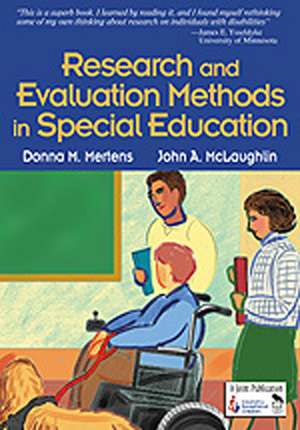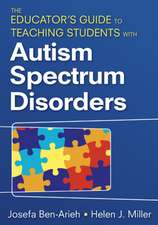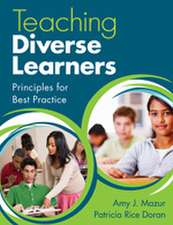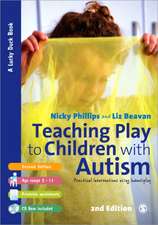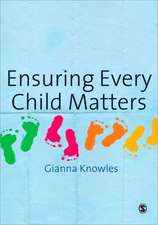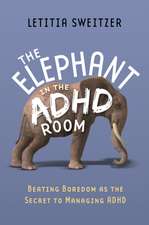Research and Evaluation Methods in Special Education
Autor Donna M. Mertensen Limba Engleză Paperback – 9 oct 2003
`This is a superb book. I learned by reading it, and I found myself rethinking some of my own thinking about research on individuals with disabilities' - James Ysseldyke, Professor, University of Minnesota
The purpose of this book is to enable the reader to use tools to design, conduct, and report research in a way that transforms, when appropriate, the delivery of special education. This book explores ways to adapt those research methods to the special education context by providing the reader with a framework for developing research questions and methods, as well as critically analyzing and conducting research focusing on the specific special education context. Unique contextual factors and populations in special education have implications for research conceptualization, design, implementation, interpretation, and reporting. Types of contextual issues specific to special education research that are addressed in this book are:
] The definition of who constitutes the special education population is not clear-cut. What are the implications of labeling someone "at risk" or disabled?
] How can appropriate identifications be made for such populations as developmentally delayed or learning disabled?
] What are the implications of conducting or critiquing research that addresses different types of functional impairments?
The audience for this book includes people who need information to support their decision-making. This includes those who set policy, administer and implement programmes, teach the students, and advocate for people with disabilities. For all these people, this book provides guidance in the conduct or critical analysis of research with special education populations. The populations that are included are primarily those that are eligible for funds under the federal government's classification system of special education students in the Individuals with Disabilities Education Act (IDEA) of 1997. Additionally, the text includes discussion of infants and toddlers with disabilities and persons with developmental delays and those at risk.
| Toate formatele și edițiile | Preț | Express |
|---|---|---|
| Paperback (1) | 326.08 lei 6-8 săpt. | |
| SAGE Publications – 9 oct 2003 | 326.08 lei 6-8 săpt. | |
| Hardback (1) | 576.58 lei 6-8 săpt. | |
| SAGE Publications – 9 oct 2003 | 576.58 lei 6-8 săpt. |
Preț: 326.08 lei
Nou
Puncte Express: 489
Preț estimativ în valută:
62.39€ • 65.32$ • 51.63£
62.39€ • 65.32$ • 51.63£
Carte tipărită la comandă
Livrare economică 05-19 aprilie
Preluare comenzi: 021 569.72.76
Specificații
ISBN-13: 9780761946533
ISBN-10: 0761946535
Pagini: 296
Dimensiuni: 178 x 254 x 16 mm
Greutate: 0.53 kg
Ediția:New.
Editura: SAGE Publications
Colecția Corwin
Locul publicării:Thousand Oaks, United States
ISBN-10: 0761946535
Pagini: 296
Dimensiuni: 178 x 254 x 16 mm
Greutate: 0.53 kg
Ediția:New.
Editura: SAGE Publications
Colecția Corwin
Locul publicării:Thousand Oaks, United States
Recenzii
"In an era when government policy emphasizes ‘scientifically based research’ (No Child Left Behind), this book provides an important resource in understanding what this means."
"This is a superb book. I learned by reading it, and I found myself rethinking some of my own thinking about research on individuals with disabilities."
"The authors have set for themselves a challenging task--to enable readers to design, conduct, report, and understand research in a way that transforms (when appropriate) the delivery of special education. What is even more amazing is it appears they have developed a guide that makes this task a reality."
"This is a superb book. I learned by reading it, and I found myself rethinking some of my own thinking about research on individuals with disabilities."
"The authors have set for themselves a challenging task--to enable readers to design, conduct, report, and understand research in a way that transforms (when appropriate) the delivery of special education. What is even more amazing is it appears they have developed a guide that makes this task a reality."
Cuprins
Preface
Acknowledgments
About the Authors
1. Introduction
Questions and Activities for Application and Discussion
2. Program Evaluation
Questions and Activities for Application and Discussion
3. Literature Review
Purposes of the Literature Review
Resources to Support the Literature Review
Reporting the Literature Review Method
Aggregating Information for a Literature Review
The Integrated Literature Review
Questions to Critically Analyze the Literature Review
Questions and Activities for Application and Discussion
4. Quantitative Research Methods: Questions of Impact
Philosophical Assumptions Associated With Quantitative Research
Questions and Activities for Application and Discussion
5. Other Quantitative Approaches: Casual Comparative, Correlational, Single Case, and Survey Research
Causal Comparative and Correlational Research
Questions for Critically Analyzing Causal Comparative and Correlational Research
Questions for Critically Anaylzing Single-Case Designs
Survey Research
Questions for Critically Analyzing Survey Research
Questions and Activities for Application and Discussion
6. Qualitative Methods
Definition and Characteristics of Qualitative Methods
Importance of Qualitative Methods in Special Education Research
Philosophical Assumptions and Methodological Implications in Special Education Research
Qualitative Methods and Data Collection Strategies
Critically Analyzing Qualitative Research
Questions for Critically Analyzing Qualitative Research
Questions and Activities for Application and Discussion
7. Mixed Methods and Mixed Model Designs
Definitions and Characteristics
Questions and Activities for Application and Discussion
8. Identification and Selection of Research Participants
Population and Sample Definition
Designing and Selecting Samples
Generalizability, External Validity, and Transferability
Ethics and Confidentiality
Questions for Critically Analyzing Sample Design and Implementation
Questions and Activities for Application and Discussion
9. Information Collection
The Purpose of Information Collection
Technical Adequacy of Data Collection Instruments
Selecting and Using a Measurement Device
Questions for Critically Analyzing Information Collection Strategies and Instruments
Questions and Activities for Application and Discussion
10. Data Analysis, Interpretation, and Use
Quantitative Data Anaylsis
Challenges in Analysis and Interpretation
Responses to Analysis and Interpretation Challenges
Qualitative Data Analysis and Interpretation
Reporting Research
Beyond Reporting: Using Research Results
Questions for Critically Analyzing Data Analysis and Interpretation
Questions and Activities for Discussion and Application
Appendices
1. Federal Definitions for Individuals with Disabilities
2. Data Sources from Extant Data Bases
3. Definitions of Statistical Terms
4. Funding Resources
5. Proposal Outline
References
Index
Acknowledgments
About the Authors
1. Introduction
Questions and Activities for Application and Discussion
2. Program Evaluation
Questions and Activities for Application and Discussion
3. Literature Review
Purposes of the Literature Review
Resources to Support the Literature Review
Reporting the Literature Review Method
Aggregating Information for a Literature Review
The Integrated Literature Review
Questions to Critically Analyze the Literature Review
Questions and Activities for Application and Discussion
4. Quantitative Research Methods: Questions of Impact
Philosophical Assumptions Associated With Quantitative Research
Questions and Activities for Application and Discussion
5. Other Quantitative Approaches: Casual Comparative, Correlational, Single Case, and Survey Research
Causal Comparative and Correlational Research
Questions for Critically Analyzing Causal Comparative and Correlational Research
Questions for Critically Anaylzing Single-Case Designs
Survey Research
Questions for Critically Analyzing Survey Research
Questions and Activities for Application and Discussion
6. Qualitative Methods
Definition and Characteristics of Qualitative Methods
Importance of Qualitative Methods in Special Education Research
Philosophical Assumptions and Methodological Implications in Special Education Research
Qualitative Methods and Data Collection Strategies
Critically Analyzing Qualitative Research
Questions for Critically Analyzing Qualitative Research
Questions and Activities for Application and Discussion
7. Mixed Methods and Mixed Model Designs
Definitions and Characteristics
Questions and Activities for Application and Discussion
8. Identification and Selection of Research Participants
Population and Sample Definition
Designing and Selecting Samples
Generalizability, External Validity, and Transferability
Ethics and Confidentiality
Questions for Critically Analyzing Sample Design and Implementation
Questions and Activities for Application and Discussion
9. Information Collection
The Purpose of Information Collection
Technical Adequacy of Data Collection Instruments
Selecting and Using a Measurement Device
Questions for Critically Analyzing Information Collection Strategies and Instruments
Questions and Activities for Application and Discussion
10. Data Analysis, Interpretation, and Use
Quantitative Data Anaylsis
Challenges in Analysis and Interpretation
Responses to Analysis and Interpretation Challenges
Qualitative Data Analysis and Interpretation
Reporting Research
Beyond Reporting: Using Research Results
Questions for Critically Analyzing Data Analysis and Interpretation
Questions and Activities for Discussion and Application
Appendices
1. Federal Definitions for Individuals with Disabilities
2. Data Sources from Extant Data Bases
3. Definitions of Statistical Terms
4. Funding Resources
5. Proposal Outline
References
Index
Notă biografică
Descriere
This excellent resource provides an approach to research and evaluation that helps educators better understand and address the needs of students with various disabilities.
